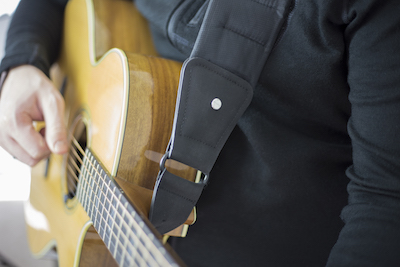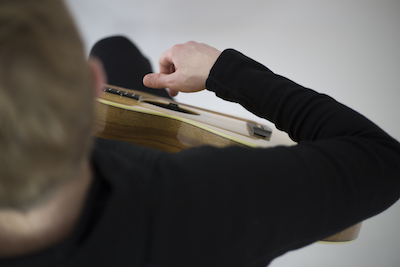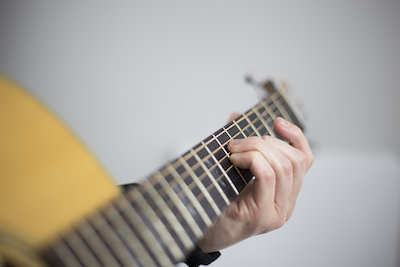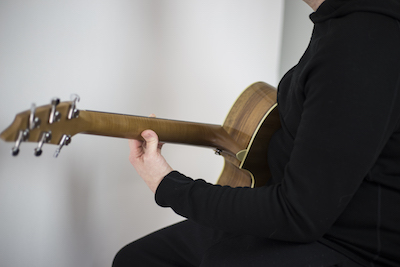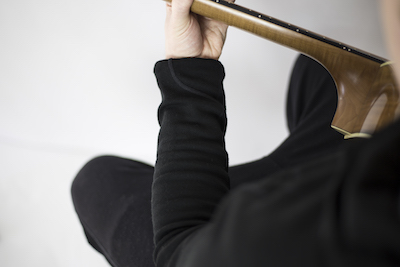How to Hold the Guitar
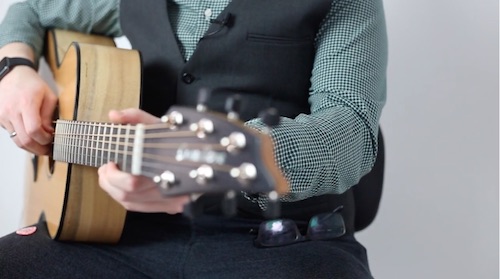
Hi I'm Grey and this is Hub Guitar. Let's talk a moment about holding the guitar. In general, I can think of about three different well established guitar playing postures. Here's the first one, which I like to call the cowboy: sit flat, in a low chair. Put your feet about shoulder with apart in a V shape. Now for most players who play with a right-handed guitar, you'll rest the curved part of the instrument on your right leg thigh . But don't hold the instrument flat against your body, let it angle out at about a 45° angle. The next posture which is also somewhat popular, I like to call the Appletini. This is a bit more cosmopolitan, and also a great choice for anybody who doesn't feel comfortable sitting with their feet apart. Again you want a low chair, crossed the right leg over the left. The curved part of the guitar rests on the thigh of your leg that's on top. The last choice is commonly associated with classical guitar, but it can be used by players of any style. For this position, you will need a small footstool to rest your leg on. This will be the left leg for right-hand players. Now that your leg is propped up high, you can rest to the guitar on your left leg side. This lets you angle the whole instrument up for a very elegant posture. It could be that none of these works quite perfectly for you. Experiment and see what makes you comfortable. You can use these starting points to develop your own guitar posture. Regardless of which posture you use, there are a few things you should keep in mind. Wearing a strap can offer you a additional support—even though the strap is thought of as away to play while standing, it also can give you extra support when you're sitting. Gripping the guitar firmly with your right arm, you can pivot the instrument off of your sternum. This applies a small amount of force that pushes the neck away from you. That will make it easier for you to push down on the strings. If you absolutely need to look at the frets on the guitar, that's understandable. But try not to hurt your posture to do it. I normally recommend you tilt the guitar outwards a little bit so you can see the frets. You don't want to spend a lot of time craning your neck over the instrument. Under normal circumstances, the guitar neck should point up just a little bit. There should be room for your fretting hand to move around. You often need to drop your wrist a lot to play the guitar so you want a generous amount of space here behind the neck, one reason why you don't want to hold the instrument to close to your body. To check on your posture briefly, first make sure your neck and back are not hunched over uncomfortably. A small amount of back support can help you. Make sure that the curves part of the guitar is resting on one of your thighs. That's what it's for. Make sure that you have room to drop down your fret hand wrist. And here's a subtle clue: looked at your feet. If they're not for touching the ground, you need to adjust something. Change your posture, get a lower chair, or use a foot stool.
The way you hold the guitar can have a big impact on your ability to play it.
If you’ve already got some playing experience, this point is easily proved. Assuming you normally play in a sitting position, just try playing the guitar in a completely different body position than normal, such as laying down, standing, or kneeling. You will likely notice it is much harder to play the guitar in some of these positions.
No matter what position you play the guitar in, here are a few points to help you get the most out of it.
Wear a Strap Always
It’s worth considering wearing a strap at all times. If you don’t have a strap, consider getting a Lock-It Guitar Strap[?]Affiliate Link.
The strap is most important when standing, as it’s quite difficult to stabilize the guitar without a strap in this position.
However, many players wear a strap when sitting as well.
The strap gives you a cheap and easy way to add support and stability to the guitar. If you’re using your muscles and the unconscious direction of your mind just to stabilize the instrument, you’re not spending those resources on actually playing it.
The strap should be adjusted to bring the guitar to the appropriate height, taking just a little bit of work off of you and allowing you to focus on playing.
Pivot the Guitar from your Sternum
A little-known secret to getting more stability is to hold the guitar in such a way that it pivots off of your sternum or breastbone.
This pivot point adds a little bit of leverage to the instrument, allowing you to firmly support the guitar neck.
You can use this pivot point to hold the guitar firmly, making it much easier to push down notes on the guitar neck.
If you play right-handed guitar, the pivot point is the right side of your torso. If you play left-handed, it’s on the left side.
If there was not any resistance behind the guitar neck, then pushing notes down on the neck would actually cause the whole guitar to be pushed back a little bit. Providing this firm resistance will help. You will not need to rely so much on your finger strength to play notes.
When it is time to play barre chords, this extra support can actually make your fretting hand feel stronger and can mean the difference between success or failure.
To Look at the Fretboard, Tilt the Guitar Out
Rather than straining your neck to look at the notes on the fretboard, you can tilt the bottom of the guitar out just a little bit, giving you a clearer view.
This is useful for seeing the notes you’re playing, but don’t get in the habit of playing this way all of the time.
Pointing the Neck Skywards
When the guitar is held in the lap by a beginner, the guitar is often a straight, horizontal line. This seems fairly intuitive. But it means that in some positions, your fretting hand may be further from the center of your body. It is usually most comfortable and ergonomic to keep your arms near your center of gravity.
Now, if you use Google images to search for images of people holding a guitar, you will notice that there are many pictures of untrained models holding the guitar in all sorts of silly positions. However, in most pictures with actual guitar players, you’ll see that the neck tends to tilt up towards the ceiling a bit.
Of course, this varies by personal preference.
It’s also worth noting that many classical players point the guitar neck very high up, and feel that this is the correct position. It is also possible to buy a Guitar Lap Support[?]Affiliate Link to put on the leg that will help position the guitar this way.
Hold the Guitar Half-way Between Parallel and Perpendicular
Many beginners hold the guitar flat against their body, and as they sit the left hand has no room to move into the complex shapes needed to play.
Imagine that the guitar was a rifle aimed to fire. You'd point the neck straight out from your body at some object.
Now imagine that the guitar was a bundle of sticks. You'd hold it close to your chest balanced lengthwise. You could not walk through doors without turning sideways.
So when sitting, you want to hold your guitar at an angle between those two points. A 45 degree angle from your center. This gives you plenty of support as you hold on to the body. And plenty of room to reach out and fret notes.
Put Your Feet Flat On The Ground
Most who play sitting will benefit from putting their feet flat on the ground. If you notice you tend to lift one foot up, consider using a foot stool for that foot. If both feet are lifting up, you need a different chair, such as a simple folding chair.
Summary of Postures
Some alternative postures are preferred by women guitar players, classical guitar players, or anybody who finds the position outlined above uncomfortable—or just unfashionable. As a recap, here are three methods that seem to work for most learners.
Cowboy Posture
Favored by many bedroom rockers. Sit with legs at shoulder width, guitar on right thigh (for right-handed players). Tilt the neck up a bit, and keep it jutting out from the body at a 45 degree angle.
Appletini Posture
A stylish and elegant posture, named for that cosmopolitan drink.
Sit with one leg crossed over the other, normally the right leg crossed over the left for right-handed players. Rest the guitar on the top of the higher of the two thighs. Some find this more “ladylike” than the squared-up posture suggested above, especially anybody who wears a skirt.
Classical Posture
Sit with the left leg (for right-handed players) propped up by a foot stool. Rest the guitar on the left thigh, slanted up towards the ceiling.
Coda
How you hold the guitar matters. If you’re holding it poorly, this can drag you down and make the whole thing harder to play. Since you’re trying to learn to play guitar, that’s the last thing you want.
 As the creator of Hub Guitar, Grey has compiled hundreds of guitar lessons, written several books, and filmed hundreds of video lessons. He teaches private lessons in his Boston studio, as well as via video chat through TakeLessons.
As the creator of Hub Guitar, Grey has compiled hundreds of guitar lessons, written several books, and filmed hundreds of video lessons. He teaches private lessons in his Boston studio, as well as via video chat through TakeLessons.